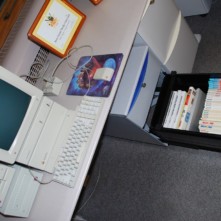Every office needs an Apple II
| Filed under Hacks & mods; 1 comment. |
Ever since I moved out of my parents’ house in 1997, I’ve not had space for a proper Apple II setup. I’d left behind two Apple IIGS computers in the basement: one from which my father ran the family business, another leftover from when I ran a dial-up BBS (1993–1997). In December 2008, I finally rescued the latter from years of inactivity when I installed it in my office cubicle.

It was a great relief, though not a surprise, to find that everything still worked fine after 11 years. Only two things failed me, both memory-based. The first was the ROM 01’s inbuilt battery, which stores various settings in the BRAM. But I had previously installed Bill Tudor’s BRAM.Checker, which stores the contents of BRAM to the hard drive on shutdown and restores them on startup, so it wasn’t a big deal. Nonetheless, it was cheap enough to buy a battery pack from ReactiveMicro.com at KansasFest 2009.
The other failing was my own memory. For more than a decade, I had relied on emulators — first Bernie ][ the Rescue, then Sweet16. I’ve now been reminded that computing on the metal is a very different experience. I was soon asking myself and others many basic questions: to ensure my revived machine is still good, how do I run a self-diagnostic test at boot time? (Hold down Open-Apple and Option.) What does it mean that the test returned “0C000003 GS Diagnostic Self-Test error/ Sound Test: Data register failed”? (It means I have a ZipGS accelerator card installed.) All sorts of little things, I had to relearn — though strangely enough, I danced around ProTERM‘s various keyboard shortcuts for several minutes before realizing I had no reason to remember these esoteric commands.
It was also vaguely embarrassing to boot up a machine that represented my teen philosophies. The startup splash screen made it clear that no IBMs were allowed, and the mouse pointer was replaced by an ominous skull. What I saw in the 1990s as amusing frivolities, I see in 2010 as a waste of resources.
The first new acquisition I made for my computer was from RetroFloppy, run by David Schmidt, creator of ADTPro. The combination of hardware and software he provided allowed me to create disk images on my Mac of the Q-Drive from which I’d run my BBS. As Jason Scott would say, I don’t know what among this data needs to be preserved, but it’s better to make backups now, lest it not be available later when I decide it is worth preserving.
My IIGS hasn’t seen a ton of use since its initial corporate installation. I sometimes spend lunch break playing Lode Runner or trying out old copies of Scholastic’s Microzine. I want to put it on the corporate network, but the Uthernet card sells as quickly as they’re produced. (I can’t wait to see the look on the helpdesk tech’s faces when they get that support ticket!) An easy way to transfer individual files between the Apple II and my MacBook would also be handy; to that end, I am an eager future customer of Rich Dreher’s CFFA3000 model of his historically popular IDE/CompactFlash interface card. I’m also awaiting the delivery of a ROM 03 machine — my first of that model, and my first Apple II purchase in eighteen years — that will serve as a backup (or maybe even a replacement) to my primary machine.
My Apple II was to be the subject of a Computerworld.com video, as I teased on the A2Unplugged podcast last year. We shot a half-hour of footage and winnowed it down to about 12 minutes, which was the longest video we’d ever produced in-house. Unfortunately, we never found the appropriate context in which to launch the video, and a few months later, its producer was laid off. We found the raw footage on his workplace hard drive, but the final cut was never found.
The bright side is that I now have a cubicle that sports three generations of Apple computers: an Apple-1, an Apple II, and a MacBook Pro. I still get some amused looks from my co-workers — unfortunately, nothing quite as delighted as this gentleman was with his surprise retrocomputer:









I wish I could bring an Apple II into work, unfortunately, they’re paranoid about having outside computers in there, and I would definitely be sent out the door immediately if I connected my (Uthernet-equipped) IIGS to the network.